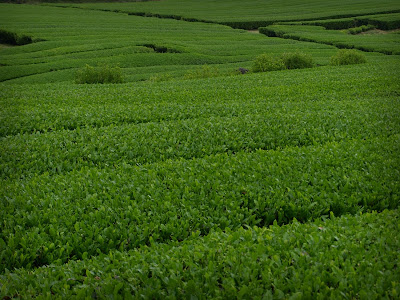One misty morning on the Island we, were fortunate enough to visit one of the most famous tea plantations in Korea, O'Sulloc. Vast rolling hills of green bushes, small wind-rounded mountains just barely mistakable through the fog and mist, a humid early morning was the perfect time to see and smell our first tea plantation. Strolling through the never ending rows of fresh green tea seemed like an experience one might have in the upper mountains of India, not on a small island just off the shore of Korea. Yet, by the end of the morning we were elated to have experienced the fields but we were also happy to be fortunate enough to catch a cab right as the rain settled into the valley.
 Unbeknownst to many people the tea bush, or tree in Northern India, is the single plant responsible for all of the major types of tea; white tea, green tea (jasmine tea), oolong tea and black tea.
Unbeknownst to many people the tea bush, or tree in Northern India, is the single plant responsible for all of the major types of tea; white tea, green tea (jasmine tea), oolong tea and black tea. The creation of different flavours are formulated through a sort of processing spectrum. The first on the spectrum is white tea. It is used as tea even thought it is un-wilted and unoxidized making it the least processed of all the teas. On the complete other end of the spectrum is black tea. It is very different from green tea in that it is wilted, crushed, and fully oxidized, making it the most processed of the common teas. The other two teas, green and oolong, fall somewhere in the middle of these two polar-extreme processing methods. So, from least processed to most processed: white tea, green tea (jasmine tea), oolong tea and black tea.
The creation of different flavours are formulated through a sort of processing spectrum. The first on the spectrum is white tea. It is used as tea even thought it is un-wilted and unoxidized making it the least processed of all the teas. On the complete other end of the spectrum is black tea. It is very different from green tea in that it is wilted, crushed, and fully oxidized, making it the most processed of the common teas. The other two teas, green and oolong, fall somewhere in the middle of these two polar-extreme processing methods. So, from least processed to most processed: white tea, green tea (jasmine tea), oolong tea and black tea. Another point of interest - To create alternately flavoured teas blending and additives are used. Herbs, flowers, spices, and fruits are blended into any of the four main types of tea to create teas such as, Earl Grey or Orange Pekoe.
Another point of interest - To create alternately flavoured teas blending and additives are used. Herbs, flowers, spices, and fruits are blended into any of the four main types of tea to create teas such as, Earl Grey or Orange Pekoe.


1 comment:
Very very interesting, thanks for the lesson! I've always wondered exactly what it was that differentiated the different kinds of tea. We had lots of strong English tea in the past couple of weeks (English only because that's where it's packaged, it's still from the east of course).
Is it really Orange Pekoke, or just Orange Pekoe?
Post a Comment